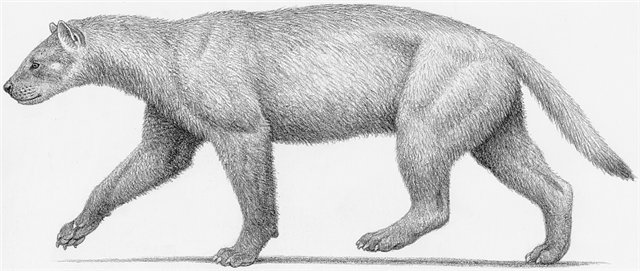Post by Infinity Blade on May 25, 2015 22:21:06 GMT 5
Ekorus ekakeran

Life restoration of E. ekakeran by Mauricio Antón.
Temporal range: Late Miocene (Messinian: 6Ma)
Scientific classification:
Life
Clade: Neomura
Domain: Eukarya
(unranked): Unikonta
(unranked): Opisthokonta
(unranked): Holozoa
(unranked): Filozoa
Kingdom: Animalia
Subkingdom: Eumetazoa
Clade: Bilateria
Clade: Nephrozoa
Superphylum: Deuterostomia
Phylum: Chordata
Subphylum: Cephalochordata
Clade: Craniata
Subphylum: Vertebrata
Infraphylum: Gnathostomata
Clade: Eugnathostomata
Clade: Teleostomi
Superclass: Tetrapoda
Clade: Reptiliomorpha
Clade: Amniota
Clade: Synapsida
Clade: Eupelycosauria
Clade: Sphenacodontia
Clade: Sphenacodontoidea
Clade/Order: Therapsida
Clade: Neotherapsida
Clade: Theriodontia
Clade: Eutheriodontia
Clade/Suborder: Cynodontia
Clade: Epicyonodontia
Infraorder: Eucynodontia
Clade: Probainognathia
Superfamily: Chiniquodontoidea
Clade: Prozostrodontia
Clade: Mammaliformes
Class: Mammalia
Subclass: Theria
Infraclass: Placentalia
Subcohort: Exafroplacentalia
Magnorder: Boreoeutheria
Superorder: Laurasiatheria
(unranked): Zooamata
(unranked): Ferae
(unranked): Carnivoramorpha
Order: Carnivora
Suborder: Caniformia
Superfamily: Musteloidea
Family: Mustelidae
Genus: †Ekorus
Species: †E. ekakeran
Ekorus ekakeran is a species of large mustelid that lived in Africa (particularly Lothagam; Kenya) during the Late Miocene epoch.[1]
Description:
Ekorus was leopard-sized (~61 centimeters tall at the shoulder) and it was suggested that it might have evolved to be more felid-like in morphology and lifestyle. The forelimbs of Ekorus show reduced emphasis on the muscles important for fossoriality (which are well-developed in the extant honey badger; Mellivora capensis). Likewise, Ekorus would have stood upright as opposed to in a crouching gait. It would have been comparatively quick for a mustelid and a large active predator.[2]
References:
[1] Jonathan Kingdon, David Happold, Thomas Butynski, Michael Hoffmann, Meredit Happold, Jan Kalina (2013). Mammals of Africa, Volumes 1-6. p. 40.
[2] Alan Turner & Mauricio Antón (2004). Evolving Eden: An Illustrated Guide to the Evolution of the African Large-Mammal Fauna. pp. 106-107.

Life restoration of E. ekakeran by Mauricio Antón.
Temporal range: Late Miocene (Messinian: 6Ma)
Scientific classification:
Life
Clade: Neomura
Domain: Eukarya
(unranked): Unikonta
(unranked): Opisthokonta
(unranked): Holozoa
(unranked): Filozoa
Kingdom: Animalia
Subkingdom: Eumetazoa
Clade: Bilateria
Clade: Nephrozoa
Superphylum: Deuterostomia
Phylum: Chordata
Subphylum: Cephalochordata
Clade: Craniata
Subphylum: Vertebrata
Infraphylum: Gnathostomata
Clade: Eugnathostomata
Clade: Teleostomi
Superclass: Tetrapoda
Clade: Reptiliomorpha
Clade: Amniota
Clade: Synapsida
Clade: Eupelycosauria
Clade: Sphenacodontia
Clade: Sphenacodontoidea
Clade/Order: Therapsida
Clade: Neotherapsida
Clade: Theriodontia
Clade: Eutheriodontia
Clade/Suborder: Cynodontia
Clade: Epicyonodontia
Infraorder: Eucynodontia
Clade: Probainognathia
Superfamily: Chiniquodontoidea
Clade: Prozostrodontia
Clade: Mammaliformes
Class: Mammalia
Subclass: Theria
Infraclass: Placentalia
Subcohort: Exafroplacentalia
Magnorder: Boreoeutheria
Superorder: Laurasiatheria
(unranked): Zooamata
(unranked): Ferae
(unranked): Carnivoramorpha
Order: Carnivora
Suborder: Caniformia
Superfamily: Musteloidea
Family: Mustelidae
Genus: †Ekorus
Species: †E. ekakeran
Ekorus ekakeran is a species of large mustelid that lived in Africa (particularly Lothagam; Kenya) during the Late Miocene epoch.[1]
Description:
Ekorus was leopard-sized (~61 centimeters tall at the shoulder) and it was suggested that it might have evolved to be more felid-like in morphology and lifestyle. The forelimbs of Ekorus show reduced emphasis on the muscles important for fossoriality (which are well-developed in the extant honey badger; Mellivora capensis). Likewise, Ekorus would have stood upright as opposed to in a crouching gait. It would have been comparatively quick for a mustelid and a large active predator.[2]
References:
[1] Jonathan Kingdon, David Happold, Thomas Butynski, Michael Hoffmann, Meredit Happold, Jan Kalina (2013). Mammals of Africa, Volumes 1-6. p. 40.
[2] Alan Turner & Mauricio Antón (2004). Evolving Eden: An Illustrated Guide to the Evolution of the African Large-Mammal Fauna. pp. 106-107.



